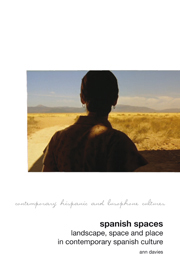Book contents
- Frontmatter
- Contents
- Acknowledgements
- List of illustrations
- 1 Introduction
- 2 Memory: landscapes of the past in Guillermo del Toro's Spanish films
- 3 Forgetting: the landscapes of Gonzalo Torrente Ballester
- 4 Landscape and identities in the Basque Country
- 5 Crime scene: landscape and the law of the land
- 6 Crime, scene, investigation: women, detection and the city
- 7 Coasting: tourism and landscape
- 8 Immigration: north (of) Africa
- 9 Conclusion
- Filmography
- Bibliography
- Index
6 - Crime, scene, investigation: women, detection and the city
- Frontmatter
- Contents
- Acknowledgements
- List of illustrations
- 1 Introduction
- 2 Memory: landscapes of the past in Guillermo del Toro's Spanish films
- 3 Forgetting: the landscapes of Gonzalo Torrente Ballester
- 4 Landscape and identities in the Basque Country
- 5 Crime scene: landscape and the law of the land
- 6 Crime, scene, investigation: women, detection and the city
- 7 Coasting: tourism and landscape
- 8 Immigration: north (of) Africa
- 9 Conclusion
- Filmography
- Bibliography
- Index
Summary
Following on from the arguments of the previous chapter, this chapter continues the consideration of the link between landscape, space and place and the law, but now focuses more squarely on the city and the presence of the female detective within texts on the city and crime. One of the key theories concerning moving through city space is that of the flâneur, a theory derived specifically from nineteenth-century Paris, theorised first by Charles Baudelaire and later by Walter Benjamin: the flâneur moves without specific purpose through the public and through public spaces but is not himself (and the gender here is specifically masculine as we shall see) of the public. Rather, he observes it. As Keith Tester says of Baudelaire's original theory, ‘The flâneur is the secret spectator of the spectacle of the spaces and places of the city’ (Tester 1994: 7). He is a man ‘driven out of the private and into the public by his own search for meaning’ (ibid.: 1) and ‘is the individual sovereign of the order of things who, as the poet or as the artist, is able to transform faces and things so that for him they have only that meaning which he attributes to them’ (ibid.: 6).
Therefore the flâneur is someone who seeks meaning from city spaces but also bestows on them individual meaning. This implies that the spaces can be read in more than one way, but what is important is this particular meaning that the flâneur produces. The ability to spectate and derive meaning from the act is, however, intrinsically masculine: in this original theorisation there can be no flâneuse.
- Type
- Chapter
- Information
- Spanish SpacesLandscape, Space and Place in Contemporary Spanish Culture, pp. 101 - 119Publisher: Liverpool University PressPrint publication year: 2012

